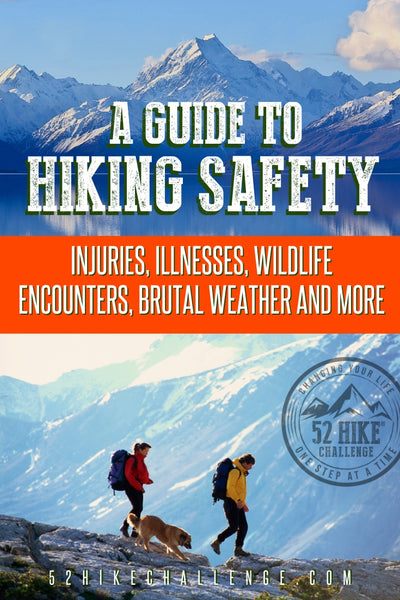
Disclaimer: Hiking in the wilderness is inherently dangerous. All of the information presented in this blog is designed to help you become a more informed hiker so you can hit the trails safely, but it is not guaranteed to protect you from the unexpected. See our Terms of Service here.
Do you know what to do if you encounter an animal on the trail?
What about if your hiking partner shows signs of dehydration or heat stroke?
What if a thunderstorm or wildfire comes out of nowhere?
While hiking is usually a pleasant experience full of great views and bonding time with your hiking buddies, the unexpected can happen at any time.
When you practice hiking safety, you reduce your risk of…
- Dehydration
- Heatstroke
- An animal attack
- Getting stuck in inclement weather
- Getting lost in the wilderness
And much, much more.
Of course, most of these hiking mishaps are out of your control. That’s why knowing how to react to hiking emergencies is not only important - it’s essential.
We want you to have fun and enjoy nature, but we also want you to be safe on the trails.
Keep reading to learn…
- What to carry with you on ALL your hikes
- How to avoid dehydration, heat stroke and injuries
- What to do if you see a bear, mountain lion or rattlesnake
- How to plan for and react to extreme weather
- What to do if you get lost in the wilderness
And much more.
First, let’s talk about general safety on the trail.

General Safety On The Trail
What’s the #1 best way for you to stay safe on a hike?
Be prepared!
Before you set out into nature, you should be physically and mentally equipped for your hike.
Top Hiking Preparedness Tips:
- Tell someone where you’re going
- Have an emergency plan
- Dress for the elements and weather
- Study the trail map and make sure to carry a backup map in a waterproof bag
- Always pack the 10 Essentials
Here at 52 Hike Challenge, we can’t stress enough the importance of packing the right gear.
Whether you’re going on a multi-day backpacking trip or a short day hike near home, you should carry the 10 Essentials at all times.
Are you curious what the 10 Essentials are?
Keep reading to find out now.
The 10 Essentials: What To Carry On ALL Your Hikes
Do you know what to pack with you on all your hikes?
The 10 Essentials should come with you on EVERY hike, long or short.
- Navigation (Map & Compass)
- Sun protection (sunscreen, lip balm, sunglasses, hat)
- Insulation (base layers / fleece / jacket)
- Illumination (headlamp)
- First aid
- Fire
- Repair kit & tools (knife, multi-tools, gear repair)
- Nutrition (snack, meals)
- Hydration (Water bottles & hydration systems)
- Emergency shelter

Now that you know what to carry at all times, let’s talk about illnesses and injuries on the trail.
Illnesses & Injuries On The Trail
While hikes vary in intensity, hiking is typically a strenuous outdoor activity performed on rough terrain that exposes you to the elements.
If you lose your footing, you risk rolling or spraining your ankle. If you slip and fall, you can break a bone or suffer from a concussion.
If you’re hiking in the heat, you risk experiencing dehydration or heat stroke.
Keep in mind we’re not telling you about these emergencies to scare you but to prepare you in the off-chance you experience them.
If any of these illnesses or injuries do happen to you, don’t panic.
Just be prepared.
You can further prepare for instances like these by taking a Wilderness Medicine Class at your local REI or local outdoor retailer.
REI offers classes on:
- Wilderness First Aid
- Managing Breaks and Strains
- Managing Blisters and Cuts
And more.
Now that you’re better prepared for illnesses and injuries on the trail, it’s time to discuss animal encounters in the wilderness.

Animal Encounters In The Wilderness
Do you know what to do if you see a bear, mountain lion, or rattlesnake on the trail?
Witnessing wildlife from a distance can be quite an incredible experience. But when you see wild animals up close, it can be dangerous for you, those around you, and for the wildlife.
Our partner REI put together a robust, informative article about Wildlife Safety.
In this helpful article above, you will learn:
- How to minimize your risk of a close animal encounter
- What to do if you encounter a bear, cougar, snake and more
- What to do (and not to do) in the event of an animal attack
In general, it’s a good idea to keep space between you and wildlife. Observe them from a distance the way nature intended. In addition, researching what flora and fauna you will encounter on your hike can better help you to prepare.
Weather And The Elements
Hiking is exhilarating because you get to spend time outside in fresh air with nothing around you but flora and fauna.
But Mother Nature won’t hold back just because you’re there.
As a hiker, you should be prepared for…
- Wildfires
- Thunderstorms
- Rain, snow, and hail
- Rapid drops or spikes in temperature
And more.
Before you set out on your hike...
- Look at the weather radar and forecast and reschedule in case of inclement weather concerns
- Reschedule your trip or have a plan B hike in case of unfavorable weather
- Always carry a rain jacket
- Check the fire danger rating
- Pack the 10 Essentials
To learn more, check out this Weather Basics article by our friends at REI.

Getting Lost In The Wilderness
How can you avoid getting lost in the wilderness?
Stay on the trail. Not only will you be following Leave No Trace Principles, but you’ll also reduce your risk of getting lost.
Carry a portable GPS. If you’re venturing off-trail (in an area where bushwhacking is allowed), it’s helpful to have a tracking device that works even when you don’t have cell service.
Carry a map in a zip lock bag. Make sure to preprint a map with your planned route or buy a map that is waterproof of the area you will be hiking in.
Use an app like AllTrails. Make sure know how to use the app and download your maps for offline use. Don't forget to carry a portable charger too.
Highly Recommended! Take a navigation class. Hone your orienteering skills by learning how to use a map and compass. Click here to find a navigation class at your local REI.
We also put together a blog, "Don’t Get Lost Hiking: How To Avoid A Search And Rescue Mission & Stay Safe On The Trail" which goes into much more detail.
Hiking Safety: What Else Do You Want To Know?
If you read this whole blog, way to go! Now you’re more prepared to hike safely in the wilderness.
At 52 Hike Challenge, it’s our mission to empower you to feel safe and comfortable spending time in nature.
So we want to know: which of these topics do you want to learn more about? Is there anything else you want to know about hiking safety?
Let us know in the comments, and we’ll provide more content for you.
 Safe & happy hiking!
Safe & happy hiking!
This page includes affiliate links in partnership with REI.
Want to remember these tips? Pin for later!



Yes, cellphones and power bank or solar charger are great ideas, but the wilderness is not completely covered with cell towers yet (Hallelujah!). Remind hikers to leave the details of their hike with a trusted contact (location, route, estimated start and finish time).
Hi Cheryl, wow – we’re glad to hear you made it off the trail safely! It’s definitely a good idea to travel with a cell phone. This could probably fit into the “navigation” category of the 10 Essentials. Perhaps it is not highlighted in the 10 Essentials because cell reception is lacking on many backcountry trails. If that’s the case, you can also carry a GPS device, a personal locator beacon (PLB) or a satellite messenger.
This blog from our partner REI dives deeper into what each of the 10 Essentials are: https://www.rei.com/learn/expert-advice/ten-essentials.html
Thanks for your feedback and happy hiking!I would think a charged cellphone would be one of the ten essentials. I was hiking in September with my adult son, and I took a very bad fall, breaking several bones making getting off the mountain highly unlikely without the help of the local emergency personnel and their equipment. Calling 911 was key!